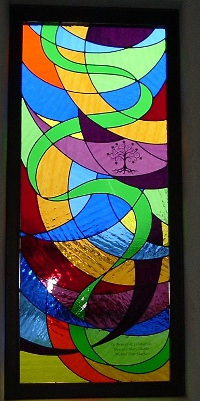A Picture PLUS A Thousand Words
 My church got new stained glass windows this week. Here’s a picture of one of them.
My church got new stained glass windows this week. Here’s a picture of one of them.
Each one is different. They have the same colors, but in different groupings, and each has a different color ribbon running through the pane.
Each also has a different picture. This one is the Tree of Life.
That got me thinking about writing (yes, everything gets me thinking about writing — everything is about writing). Although I have no figures to back this up, I venture to say that most people in the world know what a tree is. Most people know what a deciduous tree is, and that it drops its leaves in the fall, goes dormant, blooms in spring, and bears fruit (or, at least, drops seed). Most people know that a tree sends down roots and sends up branches and puts forth leaves to collect moisture and sunlight. Most people know that animals and birds shelter in trees.
Long story short (too late?), most people can look at a picture of a tree and auto-load rafts of associations, most of it positive for most people.
There are lots of objects or figures like that, which come accompanied by big bulging satchels full of associations. One way to enrich a book or story is to use the human tendency toward association to layer your meaning.
Charlotte Brontë did this in JANE EYER. As Shmoop.com says:
The day after Rochester proposes to Jane under “the great horse-chestnut at the bottom of the orchard,” that same tree gets “struck by lightning in the night, and half of it split away” (2.8.119). It can’t be a good omen to have something that’s whole get violently split in half right after two people sitting beside it decide to unite themselves.
Too right!
p.s. It doesn’t have to be trees.
A WRITING PROMPT FOR YOU: Write a paragraph centered around a cat — SHUT UP, KATYA! NOT A CAT! centered around a … damn, now I can’t think about anything but a cat. Okay, a cat.
MA




